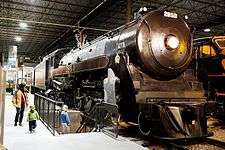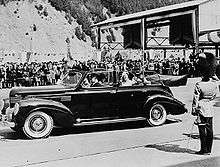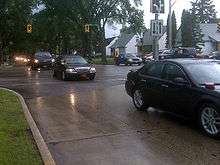Royal and viceroyal transport in Canada
Various modes of transport have been used for royal and viceroyal figures in Canada, generally for royal tours of parts of the country and viceregal official and ceremonial duties in both the provinces and the federal sphere. The technology employed has mirrored the development of transportation since the late 17th century,[1] when the first members of the Royal Family ventured from Great Britain to British North America. As the Canadian Royal Family is not predominantly resident in the country, those that belong to it have generally always had to make a trans-Atlantic crossing before switching to alternate over-land, water, or air transportation once in Canada.
Royal favour
As different forms of transportation developed in the 19th and 20th centuries, members of the Royal Family, like the general public, used them all. For instance, Albert Edward, Prince of Wales (later King Edward VII), during the first true royal tour of Canada, which he undertook in 1860, was keen to try all the different forms of conveyance available, including steam ship and locomotive. His grandson, Edward, Prince of Wales, favoured American cars and became the first member of the Royal Family to pilot an airplane and, though his brother, King George VI, was predictable and sedate in his choice of transport, George's wife, Queen Elizabeth, tried everything from golf carts to helicopters.[2] Similarly, Queen Elizabeth II has travelled in the state landau, a stagecoach, and monorail, the latter at her own personal request when touring Expo 67.[3]
Water

Up until the middle of the 20th century, ships were frequently used for royal and vice-regal tours of Canada. Members of the Royal Family would voyage from the United Kingdom to the east coast of Canada at Halifax or Saint John, or transit the Saint Lawrence River to Quebec City; from one of these ports they would then embark on a train for overland journey. The ships used were either commercial or military; for their 1939 tour, King George VI and Queen Elizabeth travelled across the Atlantic on the Canadian Pacific ship RMS Empress of Australia for the westbound voyage, and on the RMS Empress of Britain eastbound.[4][5] The royal yacht HMY Britannia was completed in 1954, and after the opening of the Saint Lawrence Seaway in 1959, could sail into the Great Lakes. This ship was decommissioned in 1997, however, and last sailed in Canadian waters in the summer of 1983, when it carried Prince Charles, Prince of Wales, and Diana, Princess of Wales.
Rail


Railways were a frequently used mode of transportation for royal and vice-royal parties from the mid-19th to mid-20th centuries; though, until the completion of the Canadian Pacific Railway (CPR), the viceregal party would have to pass through the United States in order to reach the western parts of Canada.[6] Dedicated carriages were constructed and special trains reserved for official and private trips, but, unlike other vehicles, were never owned by the monarch, either as head of state or in a private capacity; instead, they were built and maintained by the railway companies[7]—the Canadian National Railway (CNR) and the CPR—each always attempting to better the other in terms of luxury and conveniences.[8] Prince Albert Edward was in 1860 the first royal to use a train in Canada;[9] the CPR constructed for his tour two railway cars, one specifically for a sightseeing journey across the Victoria Bridge in Montreal after its opening by the Prince.[10] Then, in the 1880s, Governor General the Marquess of Lorne and his wife, Princess Louise, were supplied with a railway car named Victoria for use in both travelling around the provinces and territories and as a mobile royal and vice-royal residence in parts of the country where amenities were minimal. When it was stopped at the yet to be named capital of Saskatchewan, it was in this car that the Princess in 1882 named the new community Regina, after her mother, the Queen.[11]
For the 1901 tour of the Duke and Duchess of Cornwall and York (later King George V and Queen Mary), two railway cars were specially built by the CPR to serve as mobile royal quarters.[12] One, named Cornwall, served as the day car, with a reception room panelled in Circassian walnut with blue and gold Louis XV ornament and fitted with a piano, as well as a dining room painted in a Watteau style, and a boudoir for the Duchess lined in silk.[12] The other car, York, contained the bedrooms, reached through a green velvet lined vestibule, the Duke's in grey and crimson and the Duchess' in blue.[12] Altogether the Royal Train, which always followed the viceregal and ministerial train,[13] consisted of ten, 730-foot-long (220 m) cars,[14] the remainder being Canada, with an additional five sleeping cabins; Sandringham, the staff dining car; South Africa, housing the secretaries' offices and medical dispensary; and Australia and India, with further sleeping quarters.[13]
Three years later, the Alexandra was built and used as the primary VIP transport by members of the Royal Family, governors general, and prime ministers through to the 1920s. It was used, and, in contrast to his opinion of royal trains in Britain, enjoyed by Edward, Prince of Wales (later King Edward VIII), during his months long tours of Canada; as he said in 1919: "I progressed westward in a magnificent special train provided by the Canadian Pacific Railway. My quarters were in the rear car, which had an observation platform. This last... while providing me with a continuous view of the varied Canadian landscape had however the drawback of making me vulnerable to demands for ad lib speeches from the crowds gathered at every stop."[15] Four years later, the Prince briefly took the controls of the CPR 4-6-2 engine pulling the Royal Train.[16]
In 1926, two other carriages were built for state use: the Mount Stephen—which was used by the Duke and Duchess of Windsor; Princess Elizabeth and Prince Philip; Princess Margaret; and Princess Anne[17]—and the Wentworth—which served as car number 5 (the accommodation for then prime minister William Lyon Mackenzie King) of the Royal Train for the 1939 tour of King George VI and Queen Elizabeth. During that journey, the King, somewhat of a railbuff, rode in the engine cab when possible, and at the end of the trip gave his permission for the CPR both to use the prefix royal before the locomotive class' name of Hudson and to display the royal crown on the running boards of these engines.[18] The engines and cars were sold and dispersed in later years; the Mount Stephen and Wentworth today form a part of the CPR's Royal Canadian Pacific train; the Royal Hudson #2850 resides at the Canadian Railway Museum; and the car Pacific, purchased by Paul Higgins, the former Chairman of Mother Parker's, now sits unused on a spur line in Ajax, Ontario.[19]
Until 1959, Royal Trains operated by the Canadian Pacific Railway and the federally-owned Canadian National Railways were used to transport Queen Elizabeth II and the Duke of Edinburgh across the country. For them, and all royal parties before them travelling by train, precautions were taken ahead of the locomotive; railway line staff would be placed at platforms and on bridges for crowd control, a scout train would check for problems ahead of the royal train's arrival, and other trains that might be running parallel with the Royal Train were made to move at a different speed to prevent passengers looking into the royal carriages.[20]
Air
The Royal Family has been mostly transported since the 1960s aboard the Canadian Royal Flight, originally using a CC-137 Husky, and currently using a customized CC-150 Polaris flown by crews of 437 Transport Squadron, based at 8 Wing, Trenton, Ontario. 437 Squadron is part of the Air Transport Group, who, along with 412 Squadron in Ottawa, are charged with flying the Royal Family, the governor general, and other VIPs. Members of the Royal Family will also occasionally use commercial aircraft, such as when Queen Elizabeth II used a British Airways Concorde. Air Command helicopters and other aircraft are used where needed for shorter flights during segments of visits.
Carriage and automobile


The Canadian state landau was originally purchased by Governor General the Earl Grey from the Governor-General of Australia, where the carriage had been built in 1890s (made by Ewing Brothers in Melbourne, Australia from hand-carved wood and wrought-iron), and was in 1911 gifted by Grey to the federal King-in-Council.[21] Save for a period during the Second World War, the landau has been used for ceremonial processions through Ottawa of the governor general or members of the Royal Family, typically between the royal residence of Rideau Hall and Parliament Hill.[3] The landau is maintained by the Royal Canadian Mounted Police since 1911.
The current Queen has also used another landau, but it is not owned by the Government of Canada. The C Spring Barouche landau, owned by the Ontario Jockey Club, was a gift from E.P. Taylor. Made by Barker and Company of Britain, it has been used to transport members of the Royal Family during the Queen's Plate event in Toronto.[22]
Cars have been employed frequently to transport members of the Royal Family and governors general around localized areas of Canada. The sovereign's car bears a licence plate with a gold St. Edward's Crown on a red field.[23]
See also
- Royal tours of Canada
References
- Pigott, Peter (2005). Royal Transport: An Inside Look at the History of Royal Travel. Toronto: Dundurn Press. p. 14. ISBN 978-1-55002-572-9.
- Pigott 2005, p. 15
- Pigott 2005, p. 16
- Library and Archives Canada. "Biography and People > A Real Companion and Friend > Behind the Diary > Politics, Themes, and Events from King's Life > The Royal Tour of 1939". Queen's Printer for Canada. Archived from the original on 30 October 2009. Retrieved 12 December 2009.
- "Great Ships: Empress of Britain (II)". Archived from the original on 28 February 2008. Retrieved 23 July 2008.
- Hubbard, R.H. (1977). Rideau Hall. Montreal and London: McGill-Queen's University Press. pp. 8–9. ISBN 978-0-7735-0310-6.
- Pigott 2005, p. 25
- Pigott 2005, p. 26
- Pigott 2005, p. 29
- Pigott 2005, p. 27
- Archer, John H. (1996). "Regina: A Royal City". Monarchy Canada Magazine. Toronto: Monarchist League of Canada. Spring 1996. Archived from the original on February 9, 2008. Retrieved 30 June 2009.
- Pigott 2005, p. 30
- Pigott 2005, p. 31
- Hubbard 1977, p. 102
- Edward, Prince of Wales (1919), "Diary", in Pigott, Peter (ed.), Royal Transport: An Inside Look at the History of Royal Travel, Toronto: Dundurn Press (published 2005), p. 33, ISBN 978-1-55002-572-9, retrieved 13 December 2009
- Pogott 2005, p. 33
- Royal Canadian Pacific. "Heritage > Historical Guests". Canadian Pacific Railway. Retrieved 12 December 2009.
- "Significant dates in Canadian railway history". Colin Churcher. 17 March 2006. Archived from the original on 9 August 2007. Retrieved 17 May 2006.
- Lakey, Jack (2 February 2010), "Glorious railway relic sits on track to nowhere in Ajax", Toronto Star, retrieved 2 February 2010
- Pigott 2005, p. 24
- Bousfield, Arthur; Toffoli, Gary (2002). Fifty Years the Queen. Toronto: Dundurn Press. p. 13. ISBN 1-55002-360-8.
- http://www.pch.gc.ca/pgm/ceem-cced/fr-rf/ggd/info-eng.cfm
- "License plates from royal visits to BC". www.bcpl8s.ca. Retrieved 2020-08-02.